
Telopea speciosissima, commonly known as the New South Wales waratah or simply waratah, is a large shrub in the plant family Proteaceae. It is endemic to New South Wales in Australia and is the floral emblem of that state. No subspecies are recognised, but the closely related Telopea aspera was only recently classified as a separate species.
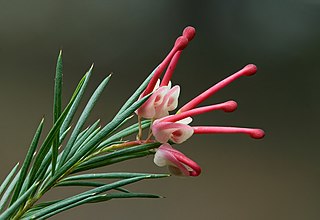
Grevillea rosmarinifolia, the rosemary grevillea, is a plant of the family Proteaceae.

Tetratheca is a genus of around 50 to 60 species of shrubs endemic to Australia. It is classified in the botanical family Elaeocarpaceae, now known to encompass the family Tremandraceae, which the genus originally belonged to. It occurs throughout extratropical Australia, and has been recorded in every mainland state except the Northern Territory.

Hakea bakeriana is a shrub in the family Proteaceae and is endemic to the Central Coast of New South Wales. It is a dense shrub with sharply pointed, cylinder-shaped leaves and pink to crimson flowers in groups of between four and twelve. The fruit is a rough, wrinkled follicle which terminates in a short beak.
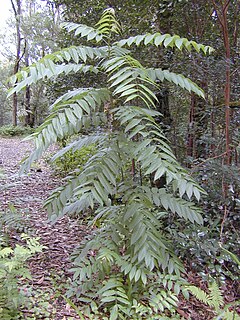
Toona ciliata is a forest tree in the mahogany family which grows throughout southern Asia from Afghanistan to Papua New Guinea and Australia. It is commonly known as the red cedar, toon or toona, Australian red cedar, Burma cedar, Indian cedar, Moulmein cedar or the Queensland red cedar. It is also known as Indian mahogany. Indigenous Australian names include Polai in the Illawarra. Woolia on the Richmond River, Mamin & Mugurpul near Brisbane, and Woota at Wide Bay.Also called Ai saria in Timor-Leste.
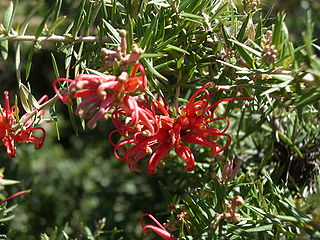
Grevillea juniperina, commonly known as juniper- or juniper-leaf grevillea or prickly spider-flower, is a plant of the family Proteaceae native to eastern New South Wales and south-eastern Queensland in Australia. Scottish botanist Robert Brown described the species in 1810, and seven subspecies are recognised. One subspecies, G. j. juniperina, is restricted to Western Sydney and environs and is threatened by loss of habitat and housing development.
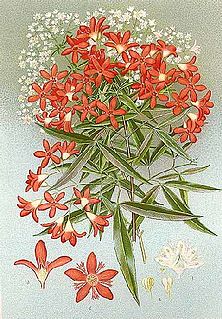
Ceratopetalum gummiferum, the New South Wales Christmas bush, is a tall shrub or small tree popular in cultivation due to its sepals that turn bright red-pink at around Christmas time. The petals are actually small and white - it is the sepals that enlarge to about 12mm after the flower sets fruit and starts to dry out.
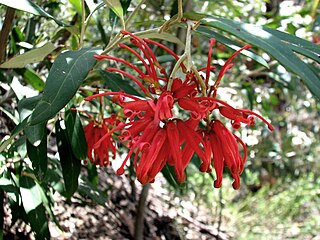
Grevillea victoriae, also known as royal grevillea or mountain grevillea, is a shrub which is endemic to south-eastern New South Wales and mountainous parts of Victoria in Australia.
Tetratheca stenocarpa, commonly known as long pink-bells, is a small shrub in the family Elaeocarpaceae. It is endemic to Victoria in Australia.

Grevillea rivularis, the Carrington Falls grevillea, is a shrub species which is endemic to New South Wales, Australia.

Tetratheca hirsuta, commonly known as black-eyed Susan, is a small shrub in the family Elaeocarpaceae. Endemic to the south-west of Western Australia, it is not related to other plants known as black-eyed Susan around the world.
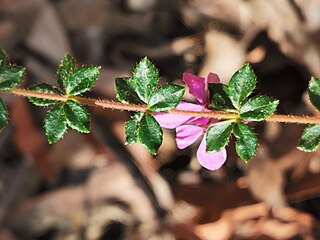
Tetratheca thymifolia, commonly known as black-eyed Susan or thyme pink-bells, is a small shrub in the family Elaeocarpaceae found in southeastern Australia.

Grevillea irrasa is a shrub species which is endemic to New South Wales in Australia. It has a spreading to erect habit, growing 1.5–3 metres high. Flowers appear between August and January in its native range. These are red, apricot or pink.
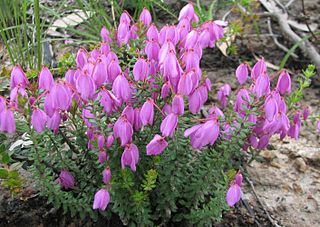
Tetratheca bauerifolia, commonly known as heath pink-bells, is a small shrub in the family Elaeocarpaceae. It is endemic to eastern Australia.It is a small shrub which may grow to 30 cm high. Deep pink flowers appear between September and December in the species' native range. The species was first formally described by Victorian Government Botanist Ferdinand von Mueller in 1853 in Synopsis Tremandrearum. It occurs in Victoria and New South Wales.

Lomatia myricoides, commonly known as the river lomatia, is a shrub native to New South Wales and Victoria in southeastern Australia.
Tetratheca juncea, commonly known as black-eyed Susan or pink bells, is a small shrub in the family Elaeocarpaceae. Endemic to New South Wales, it is not related to other plants known as Black-eyed Susan around the world.

Micromyrtus sessilis is a plant in the myrtle family, Myrtaceae and is endemic to eastern Australia. It is a dense, spreading shrub with small, more or less linear leaves and flowers that are sometimes single in the upper leaf axils or in dense clusters along the branches. It is similar to M. ciliata but has a more northerly distribution.
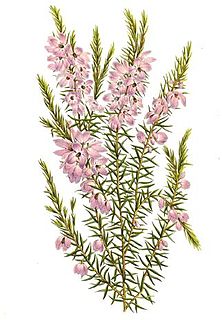
Tetratheca pilosa is a flowering plant in the family Elaeocarpaceae, endemic to Australia. It is a small shrub found in dry sclerophyll forests, open heathlands and woodlands of Australia. It was first recorded in 1805 by French botanist Jacques Labillardière.

Philotheca ciliata is a species of flowering plant in the family Rutaceae and is endemic to inland New South Wales and Queensland. It is a shrub with small, more or less cylindrical leaves and white flowers arranged singly or in two or threes on the ends of branchlets.
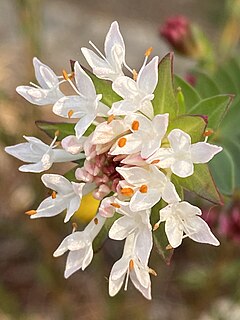
Pimelea ciliata, commonly known as white banjine, is a species of flowering plant in the family Thymelaeaceae. It is a small shrub with white flowers and is endemic to Western Australia.

















